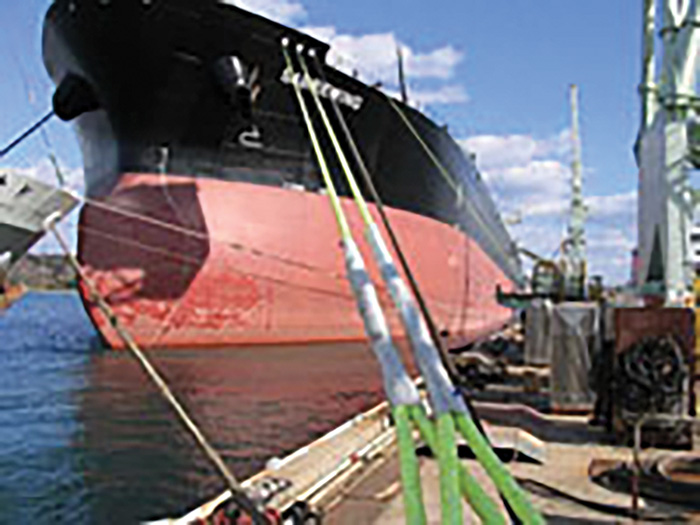Liquid crystal polyester (LCP) filament yarns made from thermotropic liquid crystalline polymer are a type of “super fiber,” which include para-aramid and ultra-high molecular weight polyethylene (UHMWPE).
Since the mass production of LCP filament yarns began in the 1990s, demand has expanded owing to their unique characteristics, such as high tenacity, high modulus, low water absorption and heat resistance.
LCP filament yarns can be produced by heat treatment of the filaments at high temperature after melt spinning. LCP has a rigid molecular structure – its molecular chains are highly oriented in the fiber axis direction owing to the stress applied to the filament during melt spinning.
During heat treatment the molecular weight is increased and crystal growth occurs owing to solid state polymerization. As a result, LCP filament yarns have improved mechanical properties to the level of so-called super fibers.
Although LCP filament yarns have superior characteristics and LCP polymer is generally available as a raw material in the resin molding field, the production of LCP filament yarns has to date been limited because of difficulties in the spinning and heat treating processes.
However, Toray Industries has developed new LCP filament yarns called Siveras, which are based on a different polymer to that of existing LCP filament yarns. The company is currently the only manufacturer that can produce both LCP polymer and fibers.
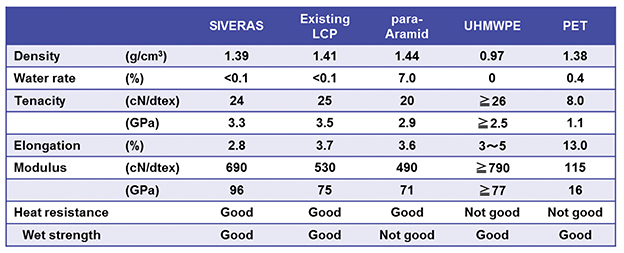
Siveras has been developed by combining polymer technology with a new spinning process, which has contributed to the creation of its unique characteristics (Figure 1). Both the tenacity and modulus of Siveras are comparable to other super fibers, and it has high wet strength and excellent thermo-stability.
Further, the creep elongation under a load of 30 percent of breaking strength is the lowest compared with para-aramid, existing LCP and UHMWPE fibers (the UHMWPE fibers were tested at 20 percent of breaking strength because they broke at 30 percent).
The results show that Siveras has excellent dimensional stability – its mechanical properties are determined by its polymer structure.
Further, Siveras can overcome problems of existing super fibers, which frequently do not exhibit the expected higher strength after processing.
For example, in ropes, although the expected strength is more than 200 kN, the actual strength using 528 yarns of existing LCP fibers with a strength of 0.4 kN is only 46 kN.
This is due to the fact that the strength of super fibers can easily decrease after processing. The fiber morphology after twisting shows that both stretched and loose single filaments are mixed in the twisted yarns; conventional super fibers also do not form a regular twisted shape (Figure 2, left middle).
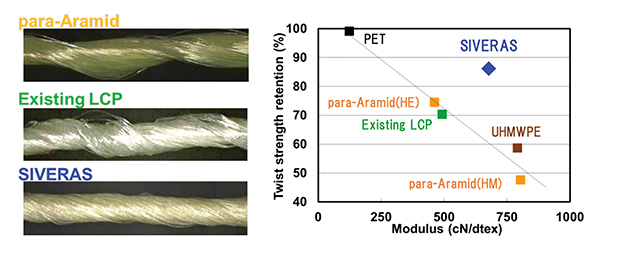
As a result, a length difference occurs between single filaments so that the yarn after twisting can be broken easily: stress is concentrated on the stretched single filaments only; loose single filaments do not contribute to the strength of the yarn.
However, Siveras can form a regular twisted shape because of the excellent filament migration in the twisted yarn due to Toray’s new spinning processes (Figure 2, left bottom).
As a result, Siveras fibers retain a higher strength after twisting, despite their higher modulus, while the strength retention ratio of other super fibers tends to decrease as filament modulus increases (Figure 2, right).
For example, the strength retention ratio of Siveras with a modulus of 690 cN/dtex after twisting is 86 percent, whereas a high-modulus para-aramid with a modulus of 800 cN/dtex and an existing LCP with a modulus of 495 cN/dtex have a strength retention ratio of 48 percent and 70 percent respectively.
These results suggest that by using Siveras, a product strength similar to that of conventional super fibers can be obtained with a smaller amount of fibers; similarly, a higher product strength can be obtained with the same amount of fibers.
The effect of this unique feature is also confirmed in actual products. The breaking strength (Figure 3, shown as a red number) and strength retention ratio (Figure 3 shown as a bar) of a knotless net manufactured using the same amount and fineness of Siveras, existing LCP and UHMWPE yarns were determined – the product using Siveras showed outstanding strength compared with other super fibers.
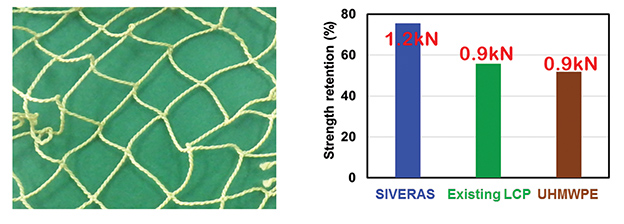
Further, Siveras has other outstanding features, such as flame, heat and acid resistance, and flexural fatigue resistance, and also offers excellent performance when used as reinforcing fiber for fiber reinforced plastic (FRP).
In addition, the measurement of vibration damping using a method based on Japanese standard JISG 0602 revealed that Siveras has a higher vibration loss coefficient than other materials (Figure 4), which shows that Siveras has a good vibration damping property.
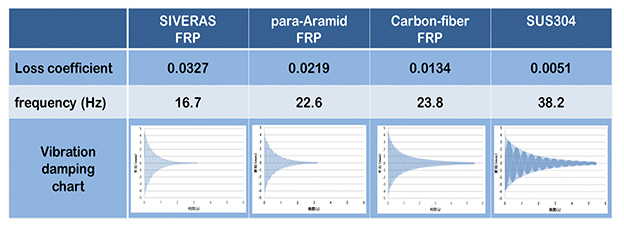
Ultraviolet (UV) resistance is the only weak point of LCP fibers, including Siveras. Although Toray is trying to overcome this technical issue through its polymer and finishing technology, Siveras can be used at present in applications not exposed to UV directly or where it is protected with other materials.


